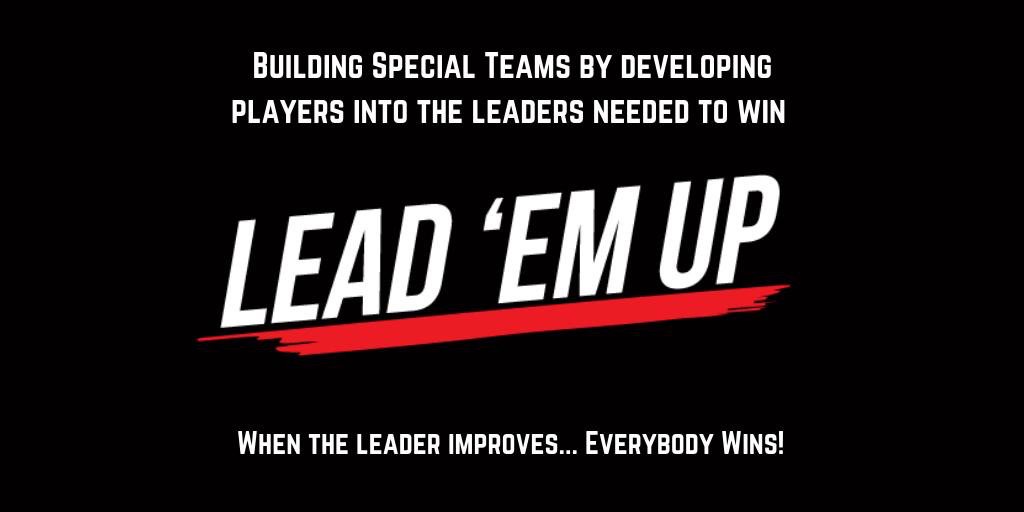Home / Blog / Self-Awareness /

As a high school and college athlete that wasn’t always the most confident when it came to leading with my voice, I did my best to lead by example. It is often said that our actions are so loud, people can’t hear what we are saying, they can only see what we are doing. I’ve always taken that fact very seriously. Unfortunately, what I failed to realize as a younger athlete is that while this is a great starting point in leadership, the best leaders do so much more.
Over the last five years as a strength and conditioning and sports performance coach, I’ve had the opportunity to work with hundreds of athletes. To be a great coach, leading by example is the absolute bare minimum requirement to being effective. Showing up on time, prepared, and with great energy isn’t the separator among great leaders. It simply provides you the opportunity to then connect with your athletes at a deeper level, which is where real leadership can then take place.
Here are three areas where leading only by example will cause you to fall short of your leadership potential:
Creating deep, lasting relationships
 As in my situation, leading only by example is usually the default for those not comfortable with communicating with others around. If your only option to lead someone else well is your example, it is easy to become inwardly focused because your leadership style revolves on the actions only you are taking.
As in my situation, leading only by example is usually the default for those not comfortable with communicating with others around. If your only option to lead someone else well is your example, it is easy to become inwardly focused because your leadership style revolves on the actions only you are taking.
This style of leadership leaves out deep, meaningful connections that are created by engaging vocally with others. It is difficult to get to know someone at surface level, let alone a deep level, if you rarely speak with them. Neglecting these types of connections with your coaches and teammates is a huge mistake. You are missing out on the incredible joy that comes from knowing and caring about someone on a deep level. You are also missing the most important aspect of leading others well, which is having a healthy relationship with them. The healthier your relationship is with someone, the more opportunities you will have to lead.
In addition, when one deep connection is made, the higher the likelihood is for another deep connection to be made. If I create a great relationship with an athlete or teammate, others close to me are much more likely to do the same with that person. One improved relationship between teammates can create a program wide spread of deeper connections. If you are only leading by example, you are letting this opportunity slip away.
Holding others accountable
Accountability is a necessity for all of us because we are imperfect people. This may be the biggest issue for those who choose to lead only by example. We will make mistakes and miss the mark at times, but having others around us who care enough about us and achieving our team goal is crucial for success. When it comes to holding others accountable, there are really only two options.
The first is to be a fear-based coach or teammate. You can hold others accountable simply by creating great consequences for their actions. Punishment running, verbal insults, or reduced playing time works to create accountability in some situations, but the long-term ramifications of these actions will almost always do more harm than good.
The second option is to have a deep connection with the person you want to hold accountable. Someone that knows you, likes you, and trusts you is much more likely to take constructive criticism positively and adjust their behavior. In a scenario where someone isn’t working as hard as they can, they are much more likely to respond to feedback about working harder from someone they know, like, and trust. The same feedback coming from someone who they barely know is not as likely to go well.
Leaders that expect to be able to hold others accountable simply by their actions and without words will miss great opportunities to help teammates be their best at all times. Leading by example, combined with words of encouragement and reminders of the commitments your team has made to each other, is the sweet spot in creating a positive environment of accountability.
Losing gray players to the red
In our Green Team exercise, the goal is to Build Green, Remove Red, and Sway Gray.
The Green represents money. Money in today’s world also means “special” (my team was money, that movie was money, his shoes were money) When our players live in the green; there’s a good chance our team will be “money” (special). Players in the green are Selfless, Hard-Working, Committed, Encouraging and Enthusiastic.
 The Gray is where the majority of our players live. Players in the gray aren’t hurting the team but also aren’t actively driving the team forward. They are neutral. On a temperature scale they would be lukewarm. They’re committed to the team but they aren’t all-in. They work hard but not all the time. They don’t stand-out, they blend-in. They’ll occasionally have good days but most days they are just going along for the ride.
The Gray is where the majority of our players live. Players in the gray aren’t hurting the team but also aren’t actively driving the team forward. They are neutral. On a temperature scale they would be lukewarm. They’re committed to the team but they aren’t all-in. They work hard but not all the time. They don’t stand-out, they blend-in. They’ll occasionally have good days but most days they are just going along for the ride.
The Red represents trouble. Similar to a business that finds themselves in the Red; if your team has played in the red, you’ll be in trouble. Players in the red are selfish, lazy, uncoachable, complainers and arrogant.
There are 7 rules to the Green Team, and I believe rules 4 and 5 fit perfectly in this context.
Rule 4 states:
Those in the gray will go where the influence is greater; green or red. Those in the gray want to be led, the question is who will lead them?
Rule 5 states:
Those in the red like when others are in the red with them. They are great recruiters. Misery likes company. Those in the red want to get others in the red to make them feel better and validate their standing.
When building the Green Team, because of the large number of players in the Gray, swaying this group to Green is huge. Leading by example may entice Gray players to become Green, but as seen in rules 4 and 5, Red players are incredible recruiters. Red players can be the most vocal in your entire team, which makes vocal leadership from Green players even more important.
For those that only want to lead by example, is it worth risking the loss of Gray players who were more influenced by the words of the Red players? To combat this, leading by example plus leading with your voice is an absolute necessity.
How to start
The simplest way to start leading with your voice is to use names, encouragement, and reminders.
Communicate your teammates’ names as much as possible during practices. Be the loudest and most frequent encourager on the team. Be the first to remind your teammates of whatever it is your coach has asked you to focus on in the particular drill you are in.
Players, I hope it is crystal clear that while leading by example is a great place to start, it is not enough. Take on the challenge of creating deep connections with all of your teammates, so that you can positively and effectively hold your teammates accountable, and begin to sway the Gray players to Green.
As we enter the summer months, we wan to provide you a tool to keep your players engaged, growing as leaders and continuing to feel connected to their team/teammates; The 21-Day Leadership Playbook.

This FREE 21-Day Leadership Playbook is filled with various Lead ‘Em Up exercises, uniquely modified for players to do on their own, as part of a team-wide exercise.

Have fun and #LeadEmUp




